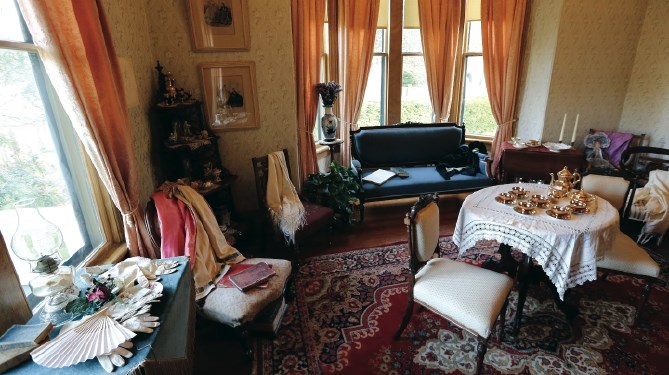Emily Carr House is alive.
The 1863 two-storey heritage building, a national and provincial Historic Site, isn’t just a beautifully restored example of the Italianate style favoured by architects of its day.
On any given day, it is alive with the sound of a kettle whistling from the kitchen, the smells of fresh-baked cookies, the sight of a delicate fine-bone china tea set on a linen tablecloth, and the sound of footsteps and conversation wafting through the house. Somewhere underfoot, Misty, an 18-year-old cat, emerges at the prospect of treats.
If Emily Carr were alive, she would immediately recognize the house, with its yellow exterior and white trim. Horse-drawn carriages still roll down Government Street in front of the home, although they are now filled with camera-toting tourists.
Followers of Carr, who died in 1945, would no doubt have read about her childhood growing up in the house in her book, The Book of Small.
READ MORE Capital Home stories
“Simply put, the house mattered to her,” says Jan Ross, the live-in curator of the home. “We know it was a loving home because she wrote of it in her journals. Even when she moved away, she wrote of how she wished the old house could fold up and fly away with her.”
The house would remain a touchstone for the artist as she embarked overseas to pursue her education or during her journeys to what were then known as the Queen Charlotte Islands to paint her famous landscapes.
After the family sold the house in 1938, it passed through a number of owners, suffering deferred maintenance over the years until demolition seemed imminent in the early 1960s.
Saved from the wrecker’s ball by Member of Parliament David Gross in 1964, the house became a community arts centre until it was acquired by the province in 1976. As an interpretive centre dedicated to Carr’s life, art and written works, it attracts more than 5,000 visitors a year.
They will immediately notice the house glowing from the thousands of hours of painstaking restorations. But the most unusual attribute could be its continued occupation.
Unlike many historic buildings, which are merely repositories of artifacts of bygone days, part of the Carr house still functions as a family home.
Ross serves as the resident curator and a steward of the property, having lived in the upper level of the two-storey house for the past 19 years. She raised her family in the house, with her two girls the first children since the Carrs to celebrate Christmas there.
In her time in residence, Ross has opened the doors to historians, architects, conservators, volunteers and fans of the artist over the years.
Some come to marvel at the dedication of volunteers, who have peeled back a century of paint and wallpaper to uncover the original pattern and colour of walls. Others come with the hope of capturing the essence of the artist.
They are seldom disappointed, with memories that fill every room, art in every corner, period bric-a-brac that line mantles and echoes from the past seeping from every pore of the house.
“It’s a unique experience,” said Ross, who began her career with a history-in-art degree from the University of Victoria. “For some, the visit is like coming on a pilgrimage. Many have seen pictures or have read her works in the past. Now they are walking in the steps, in the same rooms as the young Emily Carr.”
If the walls could talk, they would perhaps whisper that her spirit still lives there. The walls continue to display art, with contemporary art exhibitions held in the house featuring works by various local artists throughout the year.
While the province provides some of the core funding, the house still needs to generate revenue to keep the doors open.
The house is open daily between May 1 and Sept. 30. For the rest of the year it is available for private events, school field trips, day camps and weddings.
Admission is $6.75 for adults, $5.75 for seniors and students, $4.50 for children six to 18, free for children five and under, and $17 for a family.
The gift shop is stocked with a complete selection all of Carr’s vivid narratives, including her Governor General Award-winning book, Klee Wyck. It also has a comprehensive selection of posters and print images.
